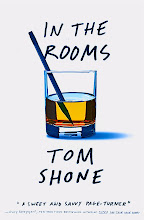skip to main |
skip to sidebar
Roland Emmerich was only half-right

“Roland
Emmerich was right,” said one screenwriter who had rung me up me excitedly to
see whether my area in Brooklyn was underwater or not. She had in mind
Emmerich’s 2004 disaster movie, The Day
After Tomorrow, which consumed New York with a giant tidal wave, although
we soon fell to swapping other cine-antecedents: 1998’s Deep
Impact, 1933’s Deluge, and Spielberg’s
A.I. with its visions of a sunken
Coney Island, underwater skyscrapers, and a statue of liberty submerged but for
its torch, now become the perch for seagulls.
Such
is the fate of New York, that when disaster strikes our first thought goes to
the movies, so repeated has the city been devastated over the years, whether by
tidal wave (Deep Impact), zombie
plague (I Am Legend) asteroid (Armageddon),
alien (Independence day), or ape (Planet of the Apes). It is the
apocalyptic city par excellence. “What a ruin it will make!” H.
G. Wells exclaimed, upon catching sight of the New York skyline, which
formed one of many indelible images from Monday night — not entirely
blacked out, but partially, from 39th street and below, which meant
that unlike the blackouts of 2003 and 1977, we got to see it at night, the buildings
of Greenwich Village just visible in silhouette against the lights further uptown.
The citizen in me was horrified, but I’d be lying if I
said that the connoisseur of apocalypse — and since 9/11 all New Yorkers
have been experts in that field — wasn’t awed and fascinated at this fresh
evidence of what happens to the city in
extremis — what Andrew Sullivan has termed “ruin porn.” Everyone
compared 9/11 to a disaster flick but
Hollywood would have made the fireballs the jets made when they hit the
side of the world trade centre much bigger; and scattered the debris much
wider. It was, curiously, the modesty of the image that terrified: seeing that
a jet makes this sized fireball when
it hits a building, and casts no debris at all, instead vaporizing on contact.
Something similar applied on Monday. What we saw was
both less than and more than the hyperbolized destruction of the movies —
not Emmerich’s tidal waves, or Spielberg’s underwater skyscrapers, but the
half-submerged streets of Hoboken; cars floating down the street like flotsam
against a grate; the beaches of New
Jersey, relocated to the street; shuttered subways, and a rising tide of briny
water. Roland Emmerich was only half
right. As Vulture noted:—
"No matter how often the eggheads told us to watch for the storm surge, not
falling skies, we still expected Death From Above — because that’s the
apocalypse we’re best rehearsed for, from Independence Day to The
Avengers. The actual onslaught turned out to be far more insidious, less
visible, with few celluloid precedents: a bubbling-up from below, a slow
submerging of our vulnerable undercarriage and the corrosion of our
centuries-old subterranean infrastructure. Sandy wasn’t the cataclysm we’d been
trailered; it was more slow-acting snakebite than one-punch obliteration. It
could color our future shared nightmares of Big Apple Armageddon, a sector of
splashy pessimism that has, for the last decade, been dominated by The Obvious."
Because Sandy made landfall in the evening, most of us
woke up to find out what had happened, the storm having moved on, leaving
behind images whose stillness more closely resembled the eerie landcapes of
fiction, rather than the movies. I was
reminded in particular of J G Ballard’s The DrownedWorld, in which the polar icecaps have melted turning Europe is "a
system of giant lagoons" and the American Midwest into "an enormous
gulf opening into the Hudson Bay.” More recently, we have had Kim
Robinson’s Forty Signs of Rain
(2005) in which rising sea levels have turned America’s cities into versions of
Venice:—
“A city floored with water. Here it was quite shallow, of course. But the
front steps of all the buildings came down into an expanse of brown water, and
the water was all at one level, as with any other lake or sea. Brown-blue,
blue-brown, brown-gray, brown, gray, dirty white – drab urban tints all. The
rain pocked it into an infinity of rings and bounding droplets, and gusts of
wind tore cats’ paws.”
The comparison with old Europe is telling. For New
York has taken up the position in the popular imagination that used to be
occupied by London, which, in the years leading up to 1916, was subjected to
repeated fictional apocalypse, in pulp novels gripped by pre-war jitters. “Great wars that devastated civilizations were fought in
the skies and on imaginary battlefields dwarfing those of Verdun and
Stalingrad,” writes literary historian W Warren Wagar. “ Fascist dictatorships led to a new
Dark Age, class and race struggles plunged civilization into Neolithic
savagery, terrorists armed with super-weapons menaced Global peace. Floods, volcanic eruptions, plagues, epochs of ice,
colliding comets, exploding or cooling suns, and alien invaders laid waste to
the world.” Sounds like a movie pitch.























No comments:
Post a Comment